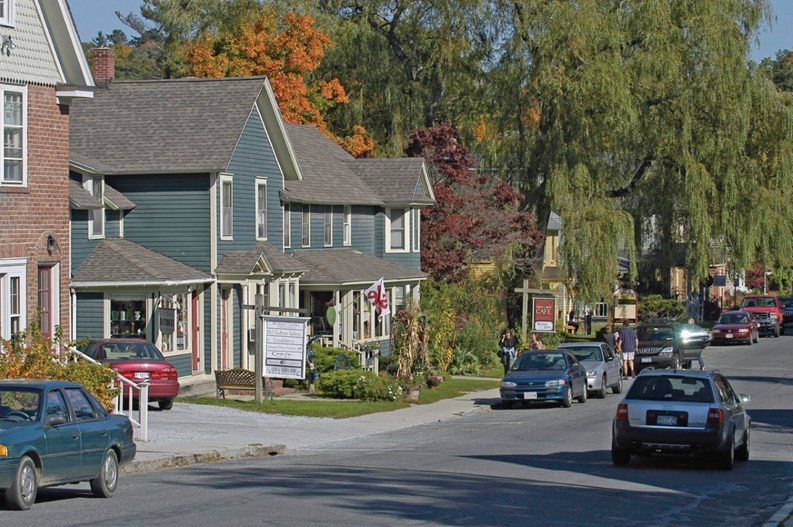Unlike many notable New England towns, Lenox, Massachusetts does not have a coastline. Nevertheless, it was once a prized destination of the rich and famous. Nestled in the Berkshires of western Massachusetts, known to some as “The American Lake District,” the town even now maintains its sense of distinction, privilege and cultural eminence.
Rough Beginnings
Now known for being the location of Tanglewood—the summer home of the Boston Symphony Orchestra— Lenox, which rests along the HousatonicRiver, was once not known at all. Its beginnings were rocky, and for many years after the first European settlements, the Berkshire area remained untouched by anyone but the native Mahican Indians. One Albany-to-Boston through-traveler in 1694 described the region as “a hideous, howling wilderness.”
Times do change, however. In 1750, Jonathan and Sarah Hinsdale must have seen a glimmer of this diamond in the rough, because they opened an inn and general store there. The Hinsdales were the first Europeans to settle in Lenox, but others soon followed suit. Typical industries of the time eventually found their place there: farming, textiles, and sawmills. Upon the discovery of a significant veinof iron ore underground, mining and ironworks, as well as potash quarries and glassworks, also thrived. For a time, Lenox was the county seat in the area, though it lost that status to Pittsfield in 1868.
In spite of the heavy industry and the earlier unfavorable traveler reviews, tastes change, too, and nineteenth century artists and entrepreneurs became aware of the beauty of Lenox and its surrounding areas. Nathaniel Hawthorne spent some time in the area, and Herman Melville wrote Moby Dick in nearby Pittsfield. It was Samuel Gray Ward, the banker who eventually funded the purchase of Alaska, who truly initiated the influx of the cultural elite to the town. He built Highwood, a vast estate there, and soon many others followed in his wake, including British actress Fannie Kemble and, later, novelist Edith Wharton. The wealthy Tappan family acquired Highwood some time later. Such newcomers understatedly called these lavish homes “cottages,” and the so-called “Cottage Era” got well under way.
A Glittering Jewel
With such an influx of high society, it is not surprising that Lenox still boasts some impressive and beautiful architecture. Though the cottages no longer belong to single families, the properties have not gone to waste. The Tappan family’s estate was converted into a concert venue and summer study center, Tanglewood, for the BSO. Shakespeare and Company has taken advantage of Wharton’s estate for its own artistic uses.
Other historic buildings in town have been otherwise converted as well. One served as the set for the film version of John Irving’s The Cider House Rules. Though the town was once home to seminaries and Biblical training centers, now various healing, retreat and recreational centers have taken their place — in the same buildings. The Kripalu Yoga Center, for example, has taken charge of the former Jesuit seminary, while the Canyon Ranch Spa now owns the Bellefontaine buildings.
Meanwhile, some of the historic properties continue to serve as residences, though not quite as they did of old. Kimball Farms has become a residence for seniors. Other such places have become condominium complexes. One of these is Morgan Manor, where a modestly-sized converted apartment recently sold for $283,000. New construction condominiums also abound. Town Assessor’s Assistant Cris Roberts, who says there are 403 condominium units in town, as compared to 1,595 single-family homes, mentions that Canyon Ranch is putting in ten high-end units. The three major developments with units valuing in the million-dollar range, Gleneagles, Colbrook, and Blossom Hill, are well-known.
In any case, the area upholds its heritage as a summering location. The year-round population, which generally hovers around 6,000, is augmented considerably by the influx of visitors in the summer. Tanglewood alone, which is as appealing for its beautiful and picnic-able grounds as for its high-quality music, draws over 300,000 visitors a year. According to the Lenox Chamber of Commerce, the population tends to soar to 35,000 in the summer.
Naturally, not every visitor stays for an extended period of time, and inns and bed-and-breakfasts are common in the area. However, much as the wealthy used to spend the summers in their expansive cottages, now many people purchase vacation condominiums and homes in Lenox, so that they can return to the town again and again. New Yorkers and Bostonians are the most likely to avail themselves of these vacation dwellings. Lenox is situated just a two-and-a half-hour drive from both cities, and summer residents maystay from May through November. Routes 7 and 20 intersect in Lenox, and the Berkshire Regional Transit Authority provides regional transport through to Pittsfield, just eight miles away. The nearest regional airport is in Pittsfield, while the closest airports with national and international flights are Albany International in New York, and Bradley International in Windsor Locks, Connecticut.
Tiffany Morawiec, a broker, owner and realtor with the Mole Agency, a long-standing family real estate company, observes that Lenox is entirely different from a metropolitan area, which is what gives it such appeal to urbanites. A maternal great-grandfather started the Mole Agency, and even in a sagging economy, it appears to do quite well because of referrals. Due to the company’s history, the referrals themselves are intergenerational; today’s clients often go to the agency because their own grandparents bought property from Morawiec’s great-grandfather. Lenox, she says, “picked up historically when it should have.”
The Mole Agency does sell some primary homes, typically pricing within the $700,000-$800,000 range. Eighty percent of the company’s business, however, comes from selling vacation properties. Seasonal cottages (in this case referring to the more modest dwellings typically referred to as cottages, and not to nineteenth-century estates) sell for around $300,000. Condominiums go for $500,000. The cost of summer houses is usually $1.4 million, with lake houses costing more than twice that amount.
Different Facets
Morawiec admits, however, that one “down-side” to the vacation home business in Lenox is that many locals can’t find homes in neighborhoods where they grew up. “Land is expensive,” she says, “and it’s rare to find developments specific to people who live and work in Berkshire County.” John Townes, in his history of Lenox on the town’s own website, cites something of a divide among the populace from years past: “On one hand, [Lenox] was acquiring the image of a vibrant oasis of culture and natural beauty. But despite the glamour that was being imposed on it, Lenox remained an essentially conservative Yankee town. The contrast between the Lenox Yankees and visitors... were the seeds of the complex and wary relationship that often still exists between locals and the outsiders who swarm into the Berkshires.”
Sue Baum of Berkshire Homes and Condominiums, however, does not seem to feel any true tension. While her firm does market vacation dwellings, they also sell a high number of year-round homes and condominiums. Their properties, she says, meet all sorts of budgets, needs and interests. As seems to be typical for Lenox, the prices range between $200,000 and millions of dollars. Baum says that the Berkshires are “still a destination,” and that the market is moving. Very favorable interest rates have helped. “Plus we just have so much to offer here,” she adds. “You’re buying into such a wonderful cultural, scenic area.”
No matter what the perspective on the different facets of the town, it is undoubtedly true that it has much to offer. The town website asserts, “Despite our strong tourist attractions and our array of accommodations, we remain primarily a residential community of approximately 6,000 people.” There is an annual open town meeting at which budgets are debated and five selectmen are elected. The town manages to maintain a small-town feel, likely because of the potential for involvement in local government. Schools in Lenox—both public and private—are exceptional. The private schools include two special education schools and a Christian school. Though there are no centers of higher education immediately in town, community colleges, state colleges, and even the University of Massachusetts/Amherst are not far away.
There is an emphasis in the town on quality of life for all of its inhabitants. Though the mining industry has closed there and the tourism industry is especially profitable, high-tech firms are also moving in, particularly specialized marketing, computer services, and even special effects designers for movies. In leisure hours, along with concerts at Tanglewood and therapy at the spas, there are hosts of other things to do, from museums to theater to dining out.
Whether one decides to live in Lenox year-round or simply to luxuriate there over the summer, there are few places to beat it for culture and beauty. It may well be, as Sue Baum claims, “the best of all worlds.”
Jennifer Grosser is a freelance writer for New England Condominium magazine.







Leave a Comment